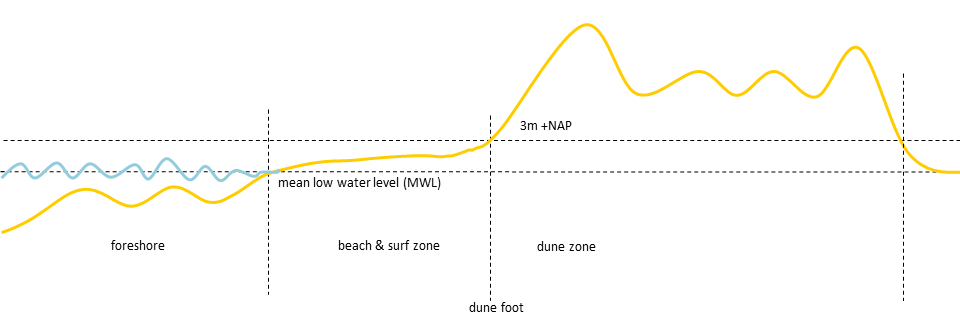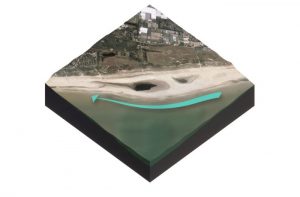Get Started
This building solution covers the spatially concentrated placement of (relatively) large sand volumes for coastal development. Such nourishments are placed at a specific location with the aim to gradually feed the surrounding coast. Wind, waves and currents will spread the sediments along the coast, which is a typical example of ‘building with nature’. Such a nourishment will contribute to the coastal safety in the long-term while creating more opportunities for nature and recreation.
An emerged concentrated nourishment along a sandy shore, whereby part of the nourishment is dry, provides more space for recreation, water sports and beach lovers. In addition, new dunes and vegetation could develop, increasing nature value. In case of an unprotected (non-enclosed) nourishment, the shape and bathymetry of the nourishment will however change continuously under the forcing of tide, wind and waves. This requires an adaptive management strategy to anticipate on unforeseen developments. The Sand Motor Delfland is a good example of an integrated solution providing safety against flooding while facilitating nature development and recreation.
In the past, erosive coasts were protected by man-made, hard structures like dikes and dams. It was soon realised that these defences often induce erosion down-drift and so softer engineering options were introduced. Structures were built that worked with the natural deposition processes occurring at the coast. Groins and breakwaters were seen as the preferred option to build up beach and dune levels in order to offer a natural barrier to the sea. In the last 15 years alternative but nowadays quite common solutions of soft nourishment were applied. Sand was placed at the location where it was directly needed, and slowly dispersing in time, while interacting with the hard structures.
Artificial coastal sand nourishments are applied for various reasons:
- to compensate losses due to (structural) erosion, and hence maintaining biodiversity
- to enhance the safety of the hinterland against flooding
- to broaden a beach or create new beaches e.g. for recreational purposes
- to reclaim new areas such as peninsulas or artificial islands for urban or industrial development
- to feed the surrounding coast with sand at a rate governed by nature
In the case of structural erosion, the nourishment will have to be repeated from time to time as the erosion is an ongoing process. The interval between successive nourishments depends on the rate of erosion and on the equipment mobilisation costs. In addition, the timing of the nourishment should be carefully chosen with respect to breeding season of species (seals, birds, etc.) and nursery habitats of fish and shrimps. Generally, an interval of five years is considered acceptable (for Dutch cases). Compared to hard solutions, nourishment is a flexible solution, while costs are spread over a longer time. For conditions along the Dutch coast this makes the soft nourishments more economical than the hard solutions with the added advantage that no lee-side erosion occurs (typical for hard solutions).
Sand nourishment can be carried out at various locations in the beach profile, such as the shoreface or foreshore (underwater), beach & surf zone and in the dune zone. In alongshore direction, the nourishment can be distributed over a large distance or placed more locally (concentrated). In the latter case, the goal of the nourishment could be to feed the adjacent coast gradually. Tide, winds and waves transport the sediments and spread it along the coast. This distribution of sand occurs gradually at rates that the adaptation of nature and species can keep up with. This enables nature and species to adapt. In case of an emerged nourishment, where part of the nourishment reaches above high water level, one can speak of a concentrated nourishment feeding the surrounding coastal area: e.g. the new beach provides new services such as recreation. A very large submerged foreshore nourishment does not provide such services; thus, for additional service for coastal development it is important that part of the nourishment is emerged and accessible (either by foot or boat). In case of an emerged concentrated nourishment the length of the shoreline increases due to the nourishment providing more space for recreation, water sports and beach lovers. In addition, new dunes and vegetation could develop increasing nature value.

Nourishments for coastal development attracts new services and hence new beach visitors (human and animals), which require a different management of the coast at the nourishment and its surroundings. In case of an non-enclosed nourishment, the shape and bathymetry of the nourishment will change continuously under the forces of tide, wind and waves. It is therefore important that an adaptive management strategy is adopted to anticipate the unforeseen and poorly predictable developments.
Shallow areas in front of hydraulic infrastructure act as a buffer for safety by dissipating wave energy. Due to the extra segment of water that is created by the rise in sea-level, a sediment shortage on many of such shoals will be created leading to a decrease in area. Nourishment can be an effective measure to fulfill the sediment demand of the shoals and maintain a dynamic equilibrium between erosion and sedimentation.
Advantages
- Concentrated nourishments feeding the surrounding coastal area can facilitate more simultaneous (ecosystem) services, like safety against flooding, nature development and recreation.
- The area to be nourished will be disturbed once in a long period while nature does the work, this can have ecological advantages.
- Tide, winds and waves transport the sediments and spread it along the coast. This distribution of sand occurs gradually at rates that nature can keep up with. This enables nature and species to adapt.
- A larger fresh water volume can be held in the dune area.
- The price of the large volume of sand for a feeder beach might be lower than the costs of the smaller volumes of sand summed up for regular nourishments.
- Mobilisation of the dredging equipment is required only once instead of regularly in the case of disposing smaller volumes regularly. This allows for optimisation in construction methods.
Disadvantages
- The evolution of the nourishment depends on the tides, wind and waves and can therefore not be fully predicted. This may lead to unforeseen or poorly predictable situations which should be managed in an adaptive manner.
- The initial sand volume of the nourishment of a feeder beach will be much larger than for a regular nourishment. Therefore, benthic species will be buried under a larger amount of sand.
- Eventually the nourishment should be repeated.

